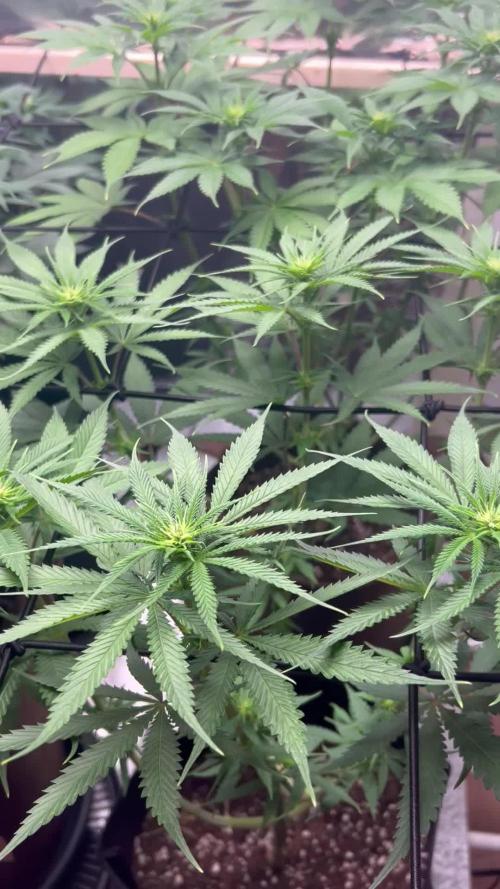By continuing to use the website or clicking Accept you consent to our cookies and personal data policy and confirm that you are at least 18 year old. For details please see Privacy Policy and Terms
Accept
Likes
Comments
Share


@mikejm
Follow
Preflower only.
Tropical Storm Hillary incoming. It is tied up to the scaffolding and will remain outdoors throughout the storm.
Likes
13
Share


@Dunk_Junk
Follow
She grew 16cm this week. Almost doubled her height.
Next couple of weeks could be interesting 😁
Likes
4
Share


@pzwags420
Follow
On day 1 I changed out my reservoir. I lowered my nutes to 650 ppm(25% reduction). I adjusted the PH down to 6.1. My left plant has some burnt tips from either PH shift or over fertilization. My hope is that the lower ppm will help to resolve the issue before it spreads.
On day 2 I adjusted the reservoirs PH from 6.3 to 5.9.
On day 3 the reservoirs PH is 6.0. I installed my new 200 watt HLG Rspec. I adjusted PPFD readings to 700-1300 PPFD on all tops.
On day 4 I adjusted the reservoirs PH from 5.8 to 6.2.
On day 5 I adjusted the reservoirs PH from 6.4 to 6.0. I diluted my nutrients in my reservoir by removing one gallon of nutrients from the rez and and adding 2 gallons of straight tap water to the rez. This brought the nute concentration from 770 ppm to 540 ppm as the plants will be entering the ripening stage in a few days and they have too much nitrogen judging by the extremely dark green leaves and burnt leaf tips on some branches of the left side plant. The buds seem slightly smaller then my last run which may be due to an excess of nitrogen and maybe not enough light as some of my tops are taller then the others making proper PPFD challenging. All in all the girls are coming along nice and I look forward to the final weeks of flowering 😀
On day 6 I adjusted the reservoirs PH from 5.9 to 6.2. I think I have halted the nute burn as I haven't seen it progressing any more on the leaves. I will continue to monitor closely during these final weeks. The trichome production is increasing with some trichs on top of colas starting to go cloudy. The pistils are turning brown with roughly 40-50% are turning brown all signs I'm getting closer to the harvest window 😆. I dimmed my light to give 600-1000 PPFD to tops.
On day 7 I reduced my temps to 75 during the day and 68 at night. I adjusted the PH of the reservoir from 6.6 to 6.1. My reservoirs ppm was too high so I diluted the rez with 2 gal of tap water. This brought it down to 480ppm. The average ppfd to all 14 tops is 604 with no top receiving more than 1000 ppfd
Likes
132
Share


@rhodes68
Follow
2/8 Week 13 !
Her drinking is falling, almost a quart less today.
Moving into flush range as the hairs are beginning to curl and seeing some small showings of amber.
Reducing the Bloom nuets to 5ml until I see its time to change again, increasing PK slightly.
Prob two days then go to full PK (15ml) to take her into flush.
Plan a fast flush with an agent to speed things along.
2/9 Fed 5ml/gal CT Bloom A/B 12ml/gal Peak
Another day
2/10 Leaving feeding as is, building nicely leaving the plant positioned as is think this is the best compromise between all the plants in the tent.
Not sure how long this will go at this point, but not cutting her short for anything.
Pics
2/12 Beginning to back off the PK leaving the CocoTek at a low dose. Plan to have the PK gone in a day or so but leaving the CT until flush.
Just following some new ideas on using PKs and Finishers.
Pics and vid of buds using a couple of filters just trying to show these two foot long buds without messing with the dark cycle.
Hope it helps
2/13 Pics that you can actually see!
Due to some issues, one is on this grow (I need to increase potency on Tara), changing out the HPS for MH for a while, may finish under it depends on the other grow.
Looking at the trics I have decided to drop the PK and go to normal levels of Bloom nuets until flush.
Continuing to keep her cleaned out as much as needed so light gets all the way down.
2/14
Pics of the rearranged tent to end the week,
Realize now how much time switching the lights to 12-12 has added to Tara's finishing time.
Had no real choice but its a point learned.
Happy with her progress
Likes
46
Share


@The_Bearded_Grower
Follow
welcome to 📅 Day 29 of the grow Day 1 of flower 7/5/2021 sorry for the late update I just found out my wife is pregnant with our first 👶.
the girls are doing great under the new grow feeding and coming along great. see you all on Thursday for my next update. Happy growing and keep your stick on the ice 🏒
Update: 📅 Day 4 of flower 7/9/2021 the girls are coming along very good and I have done the last of the pruning from here on out its just feeding
I would like to say a few words about Mars Hydro. the TS 1000 is a great light and I love the fact that the power supply is capable of being separated from the light and located outside of the tent to keep the heat down. I also like the fact that you can control the light intensity and daisy chain with another light witch is what I plan on doing.
Likes
5
Share


@FredFlintstoned
Follow
Over all growth was outstanding on this plant. Huge props to Mephisto on a wonderful strain. Caked in frost. Super stinky! I had to pop more seeds of this strain of course!
Terps exploding, even the lower larf is dense with superb resin production
Likes
25
Share

@ChickenWing1024
Follow
Great week for the black opium! pink and purple bud all around - her trichomes have started picking up on their production - the smell is an amazing skunky berry (Sometimes even a slight coffee odor) - my neighborhood must be getting some good wiff's.
Girl scout cookies probably has one more week of stretch left - did a final final final LST on her yesterday, shes loving the flat canopy - going to create some phat buds! shes got much more nodes than the auto black opium + the internode distance looks like it will allow for really well stacked buds which I am excited for!
Likes
1
Share


@phenosaurus
Follow
Runtz is a very hardy plant, has a great structure that folds well. The buds are medium sized and insanely hard, full of resin. Even the bottom buds are hard and nice when you let the light through. I definitely recommend this strain
Likes
6
Share


@Eldorado_ed
Follow
Absolutely over the moon with my first attempt really interesting and fun think I have myself a new hobby and grateful for the help from you guys on here ✌️🏻
Likes
11
Share


@Madman2020
Follow
Day 35
Sprayed With .1 Bras
Finally LSTd the 4 main stalks of each plant.
They have rebounded from the toppings on day 34.
This week is to prepare the plants for flower
Aiming for a .95VPD
Began brewing Tricantonol, liquid Karma, Calmag and Southern Ag Microbes for a Tea later this week
The video shows the training structure.
Day 37
Gave the tric brew to the plants.
Plants responded well.
Also did a final Lollipopping before flower
Day 39
Watered with no Macro Nutes.
Taking one quart of water every 2 days
Processing
Likes
4
Share


@mikolajgrows
Follow
Growing good, haven't noticed any worrying signs, RP is happy I guess in it's tent ;)
Processing
Likes
2
Share


@eldruida_lamota
Follow
Ya estoy de vuelta, hay errores con la página al subir los vídeos pero es igual, los intentaré subir otro rato si no suben ya.
Estas misty gorilla auto tienen un ritmo frenético , estoy con la modalidad LST , y la verdad que con esta variedad es muy recomendable.
Regulo el ph en 6,2 la temperatura no sube de 26 grados y la humedad oscila el 50%.
Están bajo un CFL de 250w.
Estas autos están siendo alimentadas con la gama completa de AgroBeta.
Sin zambeza y sin AgroBeta esto no es posible así que gracias 🙏.
Un saludo fumetillas.
Likes
9
Share


@midEastern
Follow
The good vegging progress is noticable as my plants no more producing buds or crystals
They are now GROWINGGGGGGGGGGGGGGGGGGGGGGGGGGGGGGGGGGGGGGGGGGGGGGGG
Likes
2
Share


@JamrockGrows
Follow
08/08 - Week 3 of flower and flowers are getting fatter. I learned from my mistakes from over defoliating which I see as a key learning curve and I will remember this for my future grows. A light watering today and I look forward to seeing more growth in the coming weeks.
Hope you have a great day!
Peace
Likes
2
Share


@Saintgrower
Follow
Last 3 days till the chop. Getting put into 36 hours of darkness prior to harvest. Trichomes are where I want them to be.
Likes
23
Share


@MadeInGermany
Follow
Hey everyone 😃.
On 09/10/20 she was placed in the flower tent at 12/12 h 😀.
You have developed incredibly well with the Green Buzz Liquid Nutrients 👍.
I am very curious how it will develop in the coming week.
Until then, I wish you all a good time and stay healthy 🙏🏻.
You can buy this Strain at
https://thecaliconnection.com/seeds/girls-scout-cookies-34.html
You can buy the fertilizer at
https://www.greenbuzzliquids.com/
Type:
Girls Scout Cookies
☝️🏼
Genetics:
GSC Tint Mint
👍
Vega lamp:
2 x Todogrow Led
Quantum Board 100 W
💡
Bloom Lamp :
2 x Todogrow Led
Cxb 3590 COB 3500 K 205W
💡💡☝️🏼
Soil :
Canna Coco Professional +
☝️🏼
Fertilizer:
Green Buzz Liquids :
Organic Grow Liquid
Organic Bloom Liquid
Organic more PK
More Roots
Fast Buds
Humic Acid Plus
Growzyme Big Fruits
Clean Fruits
Cal / Mag
Organic Ph - Pulver
☝️🏼🌱
Water:
Osmosis water mixed with normal water (24 hours stale that the chlorine evaporates) to 0.2 - 0.4 EC. Add Cal / Mag 2 ml per l water every 2 waterings . Ph with Organic Ph - Pulver to 5.8 .































